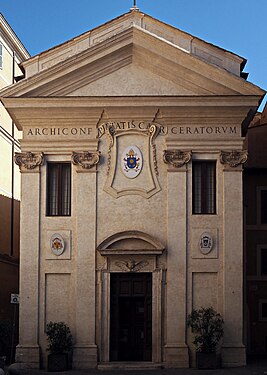San Giovanni della Pigna
| San Giovanni della Pigna | |
|---|---|
| Denomination : | Roman Catholic |
| Patronage : | John the Baptist |
| Cardinal Deacon : | Raffaele Farina SDS |
| Parish : | Santa Maria in Aquiro |
| Address: | Piazza della Pigna Roma |
Coordinates: 41 ° 53 ′ 50.4 " N , 12 ° 28 ′ 41.3" E
The Church of San Giovanni della Pigna , also San Giovanni de Pinea , is a titular deaconry in Rome in the district of Pigna , the old town of Rome. Since 1985 it has been the seat of the Diakonie San Giovanni della Pigna
history
The church stands on the Piazza della Pigna, formerly Piazza dei Porcari, named after the Roman family of the Porcari (di Pigna), who owned several properties in the quarter and whose parish church it was. It was originally dedicated to the holy martyrs Eleutherius and Genesius . Already in the year 955 the church is in a bull of Pope Agapitus II. And 962 with Pope John XII. mentioned. Since it was completely ruined in 1584, Pope Gregory XIII rejected it . the Arciconfraternita della Pietà verso i carcerati . This had the church built from scratch by the architect Angelo Torroni. After its completion in 1624 it was given the title of Sancti Ioannis de Pinea . It was renovated in the 18th century and redesigned again in 1837 under the supervision of the Roman architect Conte Virginio Vespignani (1808–1882). In 2007 the facade of the church was given its original Baroque color scheme. Pius IX assigned them in 1870 to the Order of the Salesians of San Giovanni dal Bosco. John Paul II made it the seat of the Diakonie San Giovanni della Pigna .
Exterior
The baroque style facade is divided into three parts by pilaster strips with composite capitals and finished off by a tympanum. The inscription in the frieze: ARCHICONF PIETATIS CARCERATORVM refers to the arch brotherhood. There is an angel's head above the portal and a window on each of the side panels. On the side in the Vicolo della Minerva there is still a fresco picture of the Madonna and Child and Saints Peter and Paul .
Interior
The single-nave interior goes back in its current form to a restoration in the 18th century. The nave is covered by a lunette vault. Large niches on the sides are separated by pilaster strips made of polychrome marble. There are two altars on each side. Right, the first is dedicated to Pope Eleutherius, the second to Saint Genesius. Left, the first to the Virgin Mary with altarpiece Madonna with Child and Angels , the second to Saint Teresa of Avila . The choir is separated from the nave by a balustrade, vaulted by a dome and closed off at the back by an apse. In the apse the main altar in polychrome marble. Under the altar are relics of St. Genesius kept. The altarpiece between two Corinthian columns, a work by Baldassare Croce, depicts John the Baptist (17th century). Above it is a Pietà by Luigi Garzi . In the church there were several graves of the Porcari family: Some of the tombstones are still preserved: Next to the entrance on the right Nicola Eramo de Porcari (1362) and on the left Giuliano Porcari (1282), including Giovanni Porcari, son of Nicola (1363).
Cardinal deacons
- Francis Arinze (1985-2005), then Cardinal Bishop of Velletri-Segni
- Raffaele Farina SDB (since 2007)
Picture gallery
Remarks
- ↑ Vicariatus Urbis
- ↑ The name comes from the large bronze pine cone that was found nearby and is now in the Cortile della Pigna of the Vatican Palace
- ↑ Arch- Brotherhood of Mercy for Prisoners
Literature and Sources
- Claudio Rendina: Le Chiese di Roma. Newton Compton Editori, 2007, Roma, ISBN 978-88-541-0931-5 . Pages 134-135
- Mariano Armellini, LE CHIESE DI ROMA 1891; Edizione del Pasquino - Roma
- LA GRANDE GUIDA DEI RIONI DI ROMA Newton Compton Editori, 2001, Roma, ISBN 88-8289-388-X , page 586






